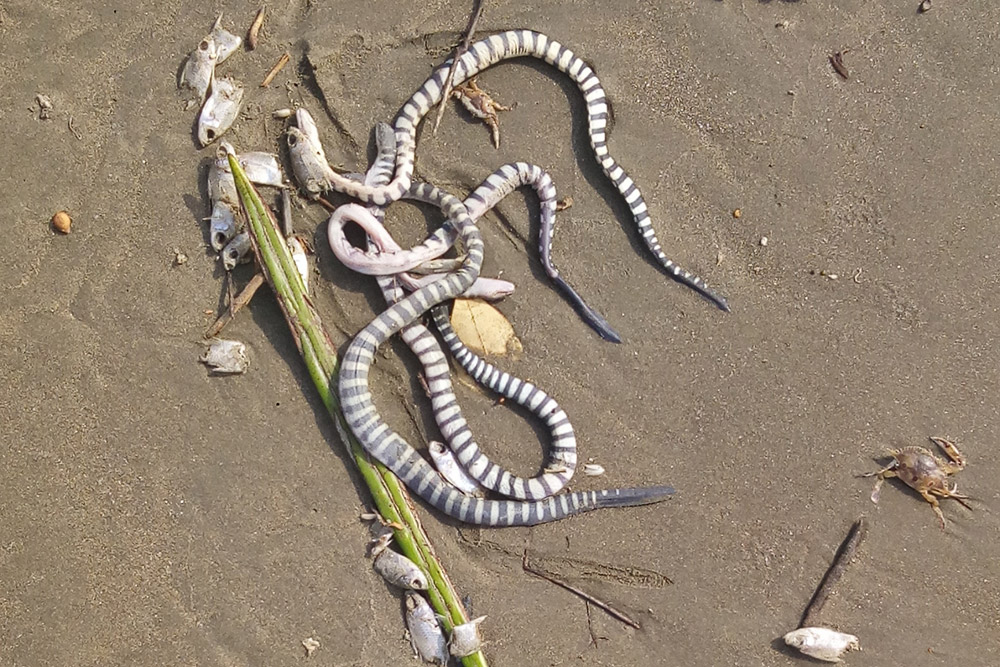
Bycatch – the incidental, unintentional take of non-commercial, non-target species or undersized animals in fishing gear — has been an ever-increasing threat to the planet’s marine life, and is today considered one of the major threats to marine biodiversity the world over. The problem of bycatch is now a widely recognised and well-documented menace to threatened wildlife, including marine mammals, sea turtles, sharks and rays, and endangered seabirds such as the wandering albatross. Witnessing first-hand the devastation caused even by a relatively small-scale fishery is, however, something I had not anticipated during a stroll on the beach.
I was out exploring a beach in Goa close to where I stay, and having seen a live sea snake on the beach the day before, I was half-expecting a similar find. Soon enough, I glimpsed the familiar form of a sea snake close to the tide line, but on getting closer, I found that it was dead. It was a juvenile Hook-nosed Sea Snake (Enhydrina schistosa), one of the commonest of sea snakes along the west coast, and the same species I had seen the previous day. As I walked on, I saw another of the same kind, also dead. To my surprise, more of them lay ahead.
As I walked further on, a whole shocking sight revealed itself, and it was of a much greater scale than I had ever imagined. There were several of these snakes scattered over a 20-30 metre stretch of the beach. A few were bone dry, one had been fed upon by crows, but a great majority of them seemed fresh enough to have died very recently. I counted a staggering eighty-one sea snakes in the area, eighty of which were juveniles of approximately 1.5 feet in length; one was an adult of the same species. Only one of these snakes was still alive, and despite almost having dried up in the baking sun, it was healthy enough to swim away when I left it below the tide line. A couple of days later, I went to take a look at the same area again and once again found a similar scene — this time there were sixty-nine dead, and once again, all but two were juveniles. Most were scattered in the same area as on the previous occasion. I was able to capture a few images with my cell phone.
The area happened to be a part of the beach where shore seines are hauled and the catch landed, which led me to guess the connection between the fishery and this mass mortality of sea snakes. My hunch was confirmed by a few local children I met on the beach the same evening, as well as by local fishermen I spoke to the following morning. Shore seines are long wall-like nets that are set in an arc in near-shore waters, and hauled towards shore by teams of fishermen pulling the two ends in. The net completely encloses the area between itself and the shore, gathering up all the animals within this area, including the sea snakes in this case.
In the course of a brief chat with the fishermen, they claimed that mass sea snake bycatch events happened multiple times a year, but they did not know much about the exact times of year when these events were expected to occur. Sea snakes are also intentionally killed for the same reason other snakes are- the fear that their mere existence and presence is a threat. On one of my excursions, I saw fishermen pick out a three-foot-long adult from their net and promptly proceed to bludgeon it, justifying the act by saying the snake was “poisonous” and “too dangerous to be released alive”. Hook-nosed sea snakes can remain active when stranded (as compared to the generally sluggish behaviour of most other sea snakes on land, barring the sea kraits), often thrashing about when handled, and it is possible that this feisty nature, in addition to the well-known toxicity of its venom, contributes to their reputation as a menace. From one fisherman’s point of view, releasing a sea snake would be a bad idea as it would continue to live there, continue to turn up in his net and hence continue to be a threat to his life.
It is clear that this problem can effectively be solved only by aiding fisher folk to alter their perception of sea snakes, understand more about the lives of these animals and acknowledge their role in maintaining the integrity of a marine ecosystem as a whole — an ecosystem which ultimately forms the very basis of their livelihood.
A special thank you to Dr. Aaron Savio Lobo for a lot of valuable learning and for encouraging me to probe deeper into this phenomenon.

 CI is a non-profit, non-commercial portal that aims to facilitate wildlife and nature conservation by providing reliable information and the tools needed to campaign effectively.
CI is a non-profit, non-commercial portal that aims to facilitate wildlife and nature conservation by providing reliable information and the tools needed to campaign effectively.
Chosen as 'Picture of the Week'
It is clear that this problem can effectively be solved only by aiding fisher folk to alter their perception of sea snakes, understand more about the lives of these animals and acknowledge their role in maintaining the integrity of a marine ecosystem as a whole -- an ecosystem which ultimately forms the very basis of their livelihood.